Featured Galleries USUBC COLLECTION OF OVER 160 UKRAINE HISTORIC NEWS PHOTOGRAPHS 1918-1997
 Holodomor Posters
Holodomor Posters

UKRAINIAN AMERICANS STRUGGLE TO GET FLEEING RELATIVES INTO UNITED STATES -- Part 1
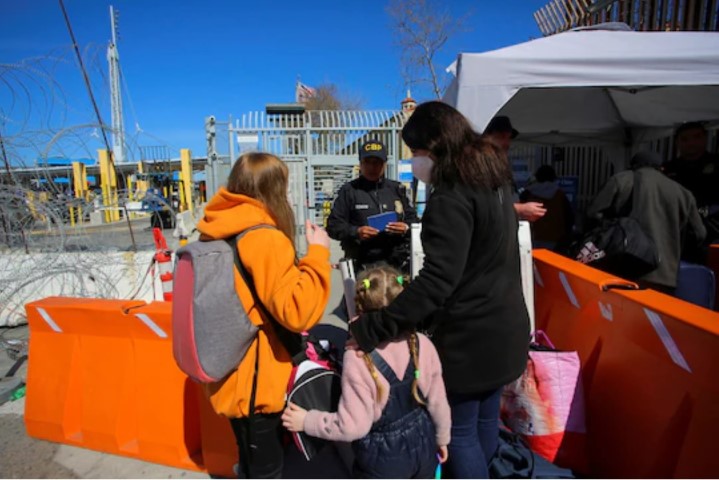 By Mark Fisher, Maria Sacchetti and Mark Shavin
By Mark Fisher, Maria Sacchetti and Mark Shavin
Washington Post, Wash, D.C., Sat, Mar 19, 2022

Ukrainian refugees pass through a checkpoint to enter the United States through Mexico. (Jorge Duenes/Reuters)
Every morning and every night, from her home in Falls Church, Va., Nadiia Khomaziuk messages her sister Lidiia in her hideaway in western Ukraine.
Is Lidiia still okay? How about her kids, who are 7 and 11? Every day, Khomaziuk scours the Internet, calls U.S. government offices and connects with lawyers and other Ukrainian Americans, in search of a path to bring her family to safety in the United States.
To get to there, Khomaziuk’s family and other Ukrainians fleeing the Russian invasion would need a visa, but the earliest appointment Khomaziuk could get for an interview for her sister at the U.S. Embassy in Warsaw is in September.
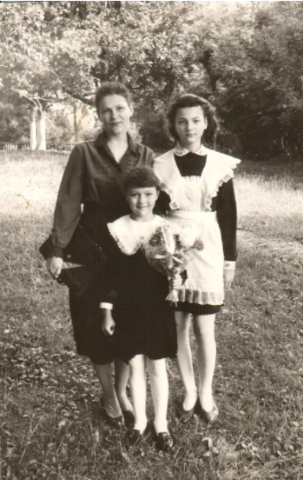
Nadiia Khomaziuk, center, poses with her sister
and mother in Zdolbuniv, Ukraine, in 1994. (Family Photo)
Lidiia, who asked that her last name not be published because of security concerns, isn’t ready to leave Ukraine. She wants to fight “till the last breath,” Khomaziuk said, though “the kids’ bags are packed, so they can jump in the car the minute they need to. But then I don’t know if I can get them here. Waiting six months for an interview just isn’t right.”
More than 3 million Ukrainians have fled their ravaged country, and the great majority of them are in the border states of Poland, Romania, Slovakia, Moldova and Hungary, according to the United Nations.
As Russian missiles obliterate more cities, refugees crowded into family basements and church social halls across Eastern Europe confront a painful choice to hold out where they are or try to be resettled as refugees, possibly in faraway countries.
Over 5,000 miles away, the reality is setting in for Ukrainian Americans eager to bring their relatives to safety that despite government pledges of solidarity, getting into the United States is a lengthy and cumbersome process that remains largely unchanged from before the war, according to those trying to bring relatives into the country and advocates who are helping them.
Still, a trickle of Ukrainians are making it to the United States to reunite with relatives, for medical care, or on tourist visas, even as many of them remain torn between craving safety for their families and feeling drawn to the mission of defeating the Russians.
Khomaziuk, who works at the U.S.-Ukraine Business Council, understands that to her sister Lidiia, a 40-year-old music teacher, this is the time to keep on baking cookies for soldiers and doing whatever she can to help other Ukrainians who’ve had to flee from burning homes.
“But I want to be able to bring my nephew and niece here,” Khomaziuk said. “I’m ready to go fly and pick them up at the border.” She remains, however, stuck in waiting mode, dependent on a U.S. visa system that is hopelessly backed up. “They really need to fly more customs people into Warsaw to speed up the process,” said Khomaziuk, 36.
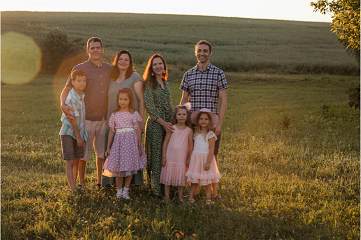
This picture from Nadiia Khomaziuk shows her with her sister
and family near Zdolbuniv last summer. (Ania Mischuk)
Some lawmakers and advocacy groups are urging the Biden administration to expedite the arrival of Ukrainians. But officials say the refugee system is not built for speed, as the U.S. vetting process often takes years.
President Biden has said he would accept up to 125,000 refugees from around the world this fiscal year, but barely 6,500 arrived between October and February, federal records show. More than 20 million refugees are under the U.N. refugee agency’s mandate, from troubled nations such as Syria, the Central African Republic and Venezuela. That number does not include more than 70,000 Afghan military interpreters and other allies the U.S. government evacuated from Afghanistan last year as the Taliban took over that country.
In the case of Ukraine, a State Department official said in a written statement, most refugees want to stay in Europe “in the hope they can return home soon” and if there are Ukrainians “for whom resettlement in the United States is a better option,” U.S. officials will work with U.N. and European officials to consider them, “bearing in mind that resettlement to the United States is not a quick process.”
One backdoor entrance to the United States that a few Ukrainians have been using is to fly to the Mexican border and beg to be allowed in. Homeland Security officials said a trickle of Ukrainians, with a daily volume in the “double digits,” have been taking advantage of the fact that they don’t need a visa to enter Mexico, so they fly to a Mexican border city, usually Tijuana, then head to the U.S. port of entry at San Ysidro, south of San Diego.
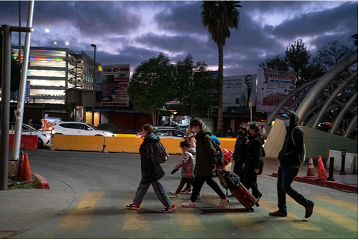
Ukrainians walk on the Mexican side of the border after trying to enter the United States.
(Guillermo Arias/AFP/Getty Images)
U.S. government data show that at least 1,300 Ukrainians were taken into custody along the Mexico border between Oct. 1 and Feb. 28. Homeland Security officials said they are allowing some Ukrainians to enter, exempting them from the public health order that U.S. authorities have used during the pandemic to turn back most asylum seekers.
“We are responding to the humanitarian crisis caused by the tragic events in Ukraine by granting humanitarian parole, on a case-by-case and temporary basis, to Ukrainians who have fled the crisis,” Homeland Security spokesman Eduardo Maia Silva told The Post.
The Biden administration is sending hundreds of millions of dollars in security and humanitarian aid, including personal hygiene kits, blankets, winter gear and food, to Ukraine and supporting European nations and nonprofits that are hosting refugees. Last week, about 75,000 Ukrainians already in the United States on student, tourist or business visas won temporary humanitarian protection from deportation, a status that will let them apply for work permits.
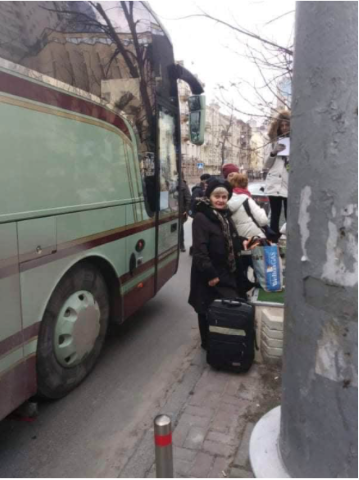
Lubov Stelmakh is about to board a charter bus leaving Kyiv
for Moldova. Her daughter, Zhenia, and son-in-law, Alan,
live in a suburb north of Atlanta. (Family Photo)
That’s not good enough for Alan and Zhenia Kaplan, an Atlanta-area couple who are desperate to get Zhenia’s 81-year-old mother, Lubov Stelmakh, to safety in Peachtree Corners, Ga., where Alan is a real estate broker and Zhenia is a homemaker.
As Kyiv came under attack, Stelmakh, who had never been outside Ukraine and was reluctant to leave, boarded a bus sponsored by an Orthodox synagogue and headed for neighboring Moldova, a long journey into a new world.
Stelmakh got on the wrong bus, Alan said, but he was grateful it took her to a synagogue in the Moldovan capital of Chisinau instead of to a large refugee center. “She is in a strange country,” Alan said, “a very hospitable, thank God, country” but “we can’t even get her here with the immigration and visa processes that we have.”
“This is a literal exodus,” said Zhenia, sitting in her den as the news on the television showed Ukrainian buildings reduced to rubble. “In every generation, there is evil. In this generation, it’s Putin.”
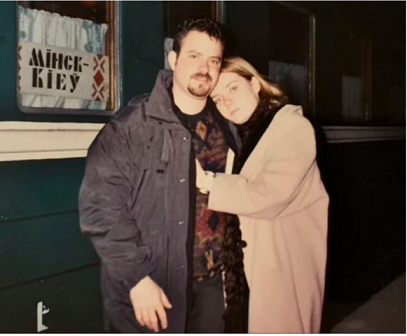
Alan and Zhenia Kaplan met on a Passover mission trip to Minsk in 1999.
They now live near Atlanta. (Family Photo)
Zhenia, 44, and Alan, 57, met on a Passover mission trip to Minsk, Belarus, in 1999. He had traveled from Atlanta and she from Kyiv to bring the biblical story of Exodus and the traditional Seder meal to communities that had lost touch with their Jewish roots under communist rule.
Now, as another exodus traps Zhenia’s relatives in a war zone, the Kaplans find themselves stuck in red tape, unable to help their family, even as the couple promises to sponsor and support them.
Zhenia’s sister, Irina, 51, made it from Kyiv to the relative safety of western Ukraine on the third day of the war, riding for 17 hours on a packed train with her 14-year-old daughter, Veronika.
With her sister in western Ukraine and her mother sleeping in a synagogue classroom in Moldova, Zhenia has been working around-the-clock to get them somewhere safe. The United States appears not to be an option.
“There is no procedure for them to even apply for a visa,” she said. “They can’t apply in Ukraine. So they have to apply in another country like Poland or Moldova.” That seems logistically impossible, but the Kaplans aren’t giving up yet. They’re now considering traveling to Moldova to press their effort to get Stelmakh to the United States or Israel.
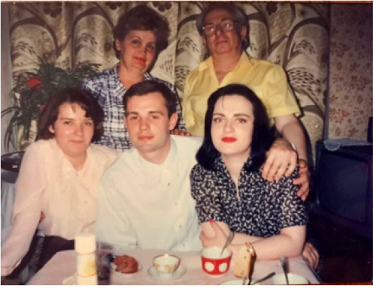 Zhenia Kaplan, left, seen with her sister, right, and parents in the back row
Zhenia Kaplan, left, seen with her sister, right, and parents in the back row
at their family home in Kyiv. (Family Photo)
Olga Hull, 40, shares their frustration. She wants to bring her younger sister, Anna, and Anna’s two young children to the United States to live with her, at least temporarily. They fled Ukraine for Poland, then the Czech Republic. Anna, who asked that her last name not be published because of security concerns, spent $500 to travel to Munich for a day to apply for a tourist visa at the U.S. Consulate.
But Anna’s costly gamble ended in frustration, as she was unable to persuade consular officials that she would stay in the United States temporarily, even after she explained that she had a job, husband, parents and a 95-year-old grandfather counting on her return to Ukraine, Hull said.
“For her, it’s kind of like an insult,” Hull said, quoting her sister’s reaction to the worry from officials that Anna might end up overstaying her tourist visa. “How can I not come back? I love my husband. My husband is there,” Anna told her.
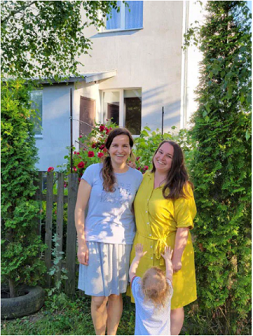
Olga Hull, left, with her younger sister, Anna, at their family home
near Rivne in Ukraine last summer. (Family Photo)











